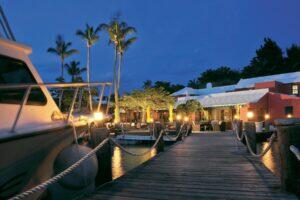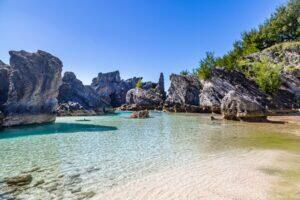Bird-Watching
Forty species of warblers have been spotted in Bermuda, especially in the casuarina trees along the south shore and West End. Other omnipresent species include kiskadee, swifts, cuckoos, flycatchers, swallows, thrushes, kingbirds, and orioles. Bird conservation is a big deal in Bermuda. You can see bluebird boxes on every island golf course, which act as safe nesting sites for this jeopardized species, threatened by development and the invasive sparrow.
The largest variety of birds can be spotted during fall migration, when thousands of birds pass overhead, stop for a rest on their way south, or spend the winter on the island. You might spot the rare American avocet or the curlew sandpiper. In spring look for brightly colored Central and South American birds migrating north. The white-tail tropic bird, a beautiful white bird with black markings and a 12- to 17-inch-long tail (locals call it a "longtail"), is one of the first to arrive. Summer is the quietest season for bird-watching in Bermuda. Late migrants, like the barn swallow and chimney swift, pass by, and if you check the ponds you may see the occasional shorebird.
Bermuda Audubon Society. The society's excellent A Birdwatching Guide to Bermuda, by president Andrew Dobson, published by the Arlequin Press, has maps, illustrations, and descriptions of birds and their habitats. It also sells a special DVD featuring the history and conservation of the East End's Nonsuch Island. Several birding events are organized throughout the year, including the Christmas Bird Count—Bermuda averages over 80 species per count, although 250 species have been recorded. You can find a listing of the Audubon Society's events on its website as well as a bird-watching checklist. Birders may also be interested in David Wingate's successful efforts to repopulate the native cahow bird population via artificial burrows on Nonsuch Island. 441/238–8628; www.audubon.bm.
Seymour's Pond Nature Reserve. Managed by the Bermuda Audubon Society, Seymour's Pond is smaller and less exciting than Warwick (central parishes) and Spittal (eastern parishes) ponds, but it has the advantage of being a bit farther inland, and therefore both better protected and better suited to serious birders. Twenty-eight species of ducks are recorded in Bermuda, and you're quite likely to see many of them here. Keep an eye out for moorhens, American coots, and pied-billed grebes, three species known to breed around this location. Middle Rd., Southampton Parish, SN04. audubon.bm.
Sherwin Nature Reserve. Also referred to as Warwick Pond, this is Bermuda's second-largest freshwater pond and prime bird-viewing territory. Shorebirds and herons gather en masse in the surrounding allspice woodland and cattail marsh during the fall and winter seasons. Note: in the heat of summer, the stagnant water lets off a rather putrid smell. Middle Rd., Warwick Parish, WK06.






